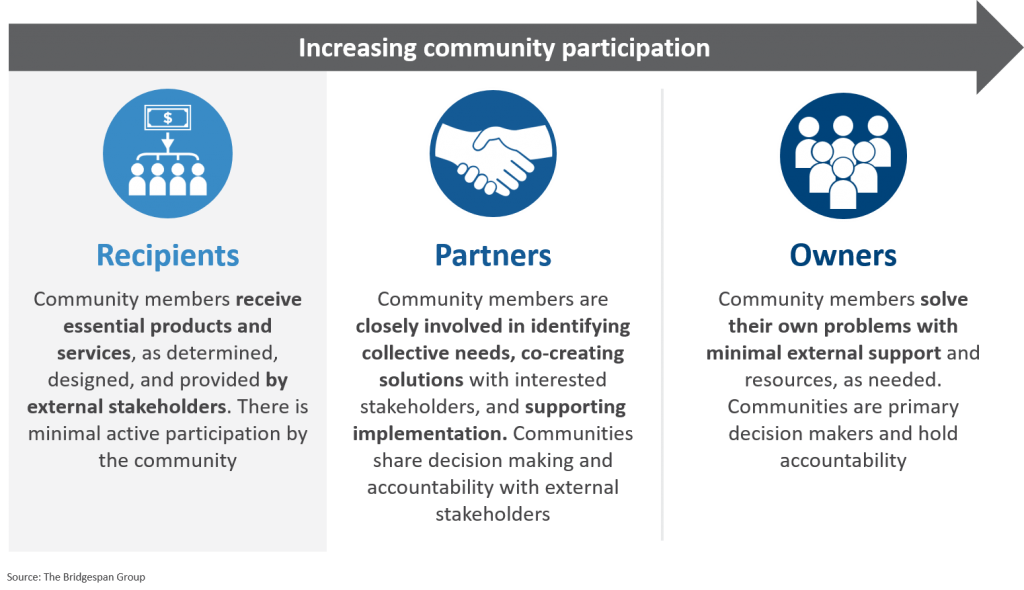Co-Author: Niloufer Memon
4 min read
As the COVID-19 crisis continues to escalate in India, halting the spread of the virus—particularly in the slums, where the spread has been exponential—is vital to the nation’s response. By late June, 96% of Mumbai’s COVID-19 containment zones were in these communities, which house more than 12 million people.
A new study from The Bridgespan Group examines how the pandemic response strategy has progressed through different community engagement models in Mumbai’s major slums. We conducted more than 45 interviews with community leaders, NGOs, government, philanthropic organisations, and other experts involved in India’s pandemic response, focusing on Dharavi, Govandi, Shivaji Nagar, Malvani, and the Kurla Belt, as well as other non-notified slums in the city such as Ambujwadi, Ambedkar Nagar, and Appa Pada.
Communities involved themselves in the pandemic response with different levels of empowerment, which we characterise as three community engagement models:
Communities as Recipients
In this model, communities receive food, healthcare, and other essential services from external stakeholders such as the government, donors, and NGOs.
COVID-19 and the lockdown challenged the basic needs of slum communities. When the lockdown began in March of 2020, Brihanmumbai Municipal Corporation supplied 24,000 packets of dry rations and 19,000 food packages to containment zones in Dharavi every day. Swasth Foundation and Praja Foundation followed up with dry ration kits, with community volunteers assisting with packaging and distribution, and Project Mumbai and the Society for Nutrition, Education & Health Action (SNEHA) are offering mental health and crisis helplines, respectively.
In this model, it falls primarily upon external stakeholders to assess community needs, design and implement solutions, and account for results. The model is effective for delivering immediate aid but is disempowering and less sustainable over the longer term.
Communities as Partners
Under this approach, community members actively participate with governments and NGOs in identifying their needs, developing solutions, and supporting implementation.
The ongoing collaboration between SNEHA and community action groups (CAGs) in Dharavi, Govandi, and Malvani embodies this model. Since 1999, SNEHA has created and trained this cadre of community volunteers, who connect the community to public health services and promote health-seeking behaviours.
Their partnership is working well for the pandemic response due to the active role of the CAGs, which has enabled SNEHA to communicate COVID-19 awareness, control, and prevention messages that are contextualised to the communities and translated to local languages. Additionally, CAGs have enlisted hyperlocal, trusted community actors, such as rickshaw drivers and faith leaders, to deliver these messages to families.
While the lockdown has made interactions and deliveries more challenging, organisations such as SNEHA, which have preexisting, strong relationships within slums and local government support, have been able to incorporate community input and partnerships in their COVID-19 response.
Communities as Owners
Here, communities identify their own needs, design and implement solutions largely independently, and seek external support only to cover gaps in local resources or expertise.
Members of Malvani Yuva Parishad—a youth collective in a non-notified slum called Ambujawadi—operate autonomously to address their communities’ needs. The youth collective is currently mobilising resources to address the most urgent needs—for example, manufacturing masks, operating community kitchens, and seeking water from local government.
This model is uncommon even in normal times, and is much less prevalent amid the pressures of the pandemic. But it is the model most likely to build communities’ capacity to recover from shocks and stresses. Success comes from strong peer networks, high social capital, trusted influencers in communities, and a culture of mutual aid. Building these structures in resource-poor settings takes effort and investment—through training, developing skills, forming local collectives—by all stakeholders, over many years.
Supporting inclusive development in slums
An understanding of community engagement models can be illuminating for those working—or aspiring to work—with slum communities in the context of COVID-19, other infectious diseases, or future shocks. Our research found three critical ways for policymakers, funders, and practitioners to better engage communities: understanding the slum’s context and unique characteristics; adapting to evolving needs and flexibly moving across the engagement models within and across slums; and, nurturing social support networks and equipping them with requisite skills and knowledge to craft and implement their own development agenda.
Facilitating community engagement as the pandemic eases will allow slums to bounce back stronger—and likely lead to more inclusive development centred on the communities’ dignity and self-reliance. In addition, building resilient communities that are better prepared to handle future shocks would involve empowering and enabling them to move closer to the Partners or Owners model. Please read the report and engage with us, or learn how fellow AVPN members are working to alleviate the COVID-19 crisis in their communities.



















